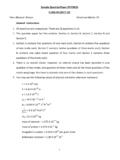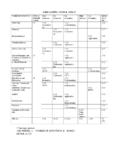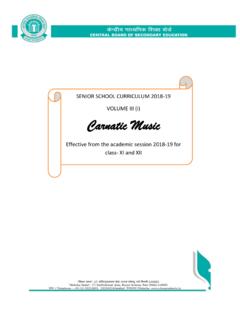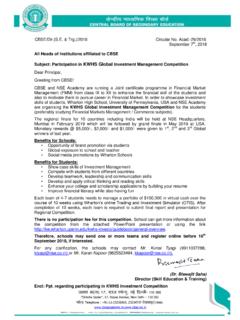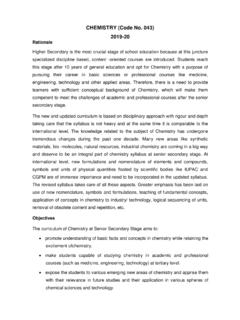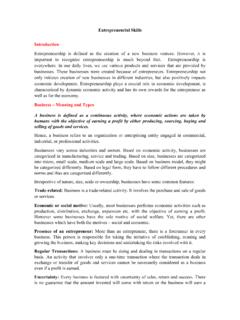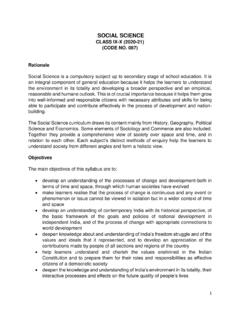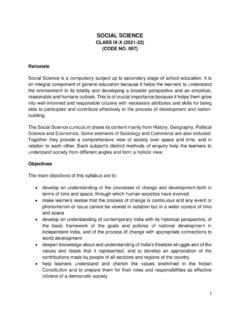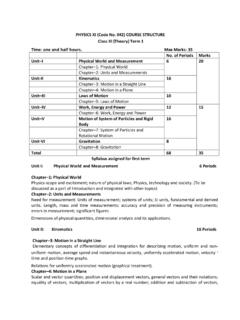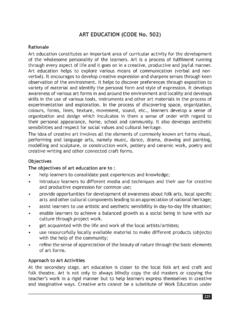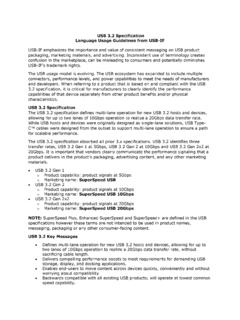Transcription of SCIENCE (Code No. 086) Classes: IX and X (2021-22)
1 SCIENCE (Code No. 086) Classes: IX and X (2021-22) The subject of SCIENCE plays an important role in developing well-defined abilities in cognitive, affective and psychomotor domains in children. It augments the spirit of enquiry, creativity, objectivity and aesthetic sensibility. Upper primary stage demands that a number of opportunities should be provided to the students to engage them with the processes of SCIENCE like observing, recording observations, drawing, tabulation, plotting graphs, etc., whereas the secondary stage also expects abstraction and quantitative reasoning to occupy a more central place in the teaching and learning of SCIENCE . Thus, the idea of atoms and molecules being the building blocks of matter makes its appearance, as does Newton s law of gravitation.
2 The present syllabus has been designed around seven broad themes viz. Food; Materials; The World of The Living; How Things Work; Moving Things, People and Ideas; Natural Phenomenon and Natural Resources. Special care has been taken to avoid temptation of adding too many concepts than can be comfortably learnt in the given time frame. No attempt has been made to be comprehensive. At this stage, while SCIENCE is still a common subject, the disciplines of Physics, Chemistry and Biology begin to emerge. The students should be exposed to experiences based on hands on activities as well as modes of reasoning that are typical of the subject. Curricular Expectations At this stage learners are expected to: develop understanding of concepts, principles, theories, and laws governing the physical world, consistent with the stage of cognitive development.
3 Develop ability to acquire and use the methods and processes of SCIENCE , such as observing, questioning, planning investigations, hypothesising, collecting, analyzing and interpreting data, communicating explanations with evidences, justifying explanations, thinking critically to consider and evaluate alternative explanation, etc. conduct experiments, also involving quantitative measurements. appreciate how concepts of SCIENCE evolve with time giving importance to its historical prospective. develop scientific temper (objectivity, critical thinking, freedom from fear and prejudice, etc.). nurture natural curiosity, aesthetic sense, and creativity. imbibe the values of honesty, integrity, cooperation, concern for life and preservation of environment.
4 Develop respect for human dignity and rights, equity and equality. General Instructions: 1. There will be an Annual Examination based on the entire syllabus. 2. The Annual Examination will be of 80 marks and 20 marks weightage shall be for Internal Assessment. 3. For Internal Assessment: a. There will be Periodic Assessment that would include: For 5 marks- Three periodic tests conducted by the school. Average of the best two tests to be taken that will have a weightage of 05 marks towards the final result. For 5 marks- Diverse methods of assessment as per the need of the class dynamics and curriculum transaction. These may include - short tests, oral test, quiz, concept maps, projects, posters, presentations and enquiry based scientific investigations etc.
5 And use rubrics for arguing them objectively. This will also have a weightage of 05 marks towards the final result. b. Practical / Laboratory work should be done throughout the year and the student should maintain record of the same. Practical Assessment should be continuous. There will be weightage of 5 marks towards the final result. All practicals listed in the syllabus must be completed. c. Portfolio to be prepared by the student- This would include classwork and other sample of student work and will carry a weightage of 5 marks towards the final results. COURSE STRUCTURE CLASS IX (Annual Examination) Marks: 80 Unit No. Unit Marks Periods I Matter - Its Nature and Behaviour 23 50 II Organization in the Living World 20 45 III Motion, Force and Work 27 60 IV Our Environment 06 15 V Food; Food Production 04 10 Total 80 Internal assessment 20 Grand Total 100 Theme: Materials (50 Periods) Unit I: Matter-Nature and Behaviour Definition of matter; solid, liquid and gas; characteristics - shape, volume, density; change of state-melting (absorption of heat), freezing, evaporation (cooling by evaporation), condensation, sublimation.
6 Nature of matter: Elements, compounds and mixtures. Heterogeneous and homogenous mixtures, colloids and suspensions. Particle nature and their basic units: Atoms and molecules, Law of constant proportions, Atomic and molecular masses. Mole concept: Relationship of mole to mass of the particles and numbers. Structure of atoms: Electrons, protons and neutrons, valency, chemical formula of common compounds. Isotopes and Isobars. Theme: The World of the Living (45 Periods) Unit II: Organization in the Living World Cell - Basic Unit of life : Cell as a basic unit of life; prokaryotic and eukaryotic cells, multicellular organisms; cell membrane and cell wall, cell organelles and cell inclusions; chloroplast, mitochondria, vacuoles, endoplasmic reticulum, Golgi apparatus; nucleus, chromosomes - basic structure, number.
7 Tissues, Organs, Organ System, Organism: Structure and functions of animal and plant tissues (only four types of tissues in animals; Meristematic and Permanent tissues in plants). Biological Diversity: Diversity of plants and animals-basic issues in scientific naming, basis of classification. Hierarchy of categories / groups, Major groups of plants (salient features) (Bacteria, Thallophyta, Bryophyta, Pteridophyta, Gymnosperms and Angiosperms). Major groups of animals (salient features) (Non-chordates upto phyla and chordates upto classes). Health and Diseases: Health and its failure. Infectious and Non-infectious diseases, their causes and manifestation. Diseases caused by microbes (Virus, Bacteria and Protozoans) and their prevention; Principles of treatment and prevention.
8 Pulse Polio programmes. Theme: Moving Things, People and Ideas (60 Periods) Unit III: Motion, Force and Work Motion: Distance and displacement, velocity; uniform and non-uniform motion along a straight line; acceleration, distance-time and velocity-time graphs for uniform motion and uniformly accelerated motion, derivation of equations of motion by graphical method; elementary idea of uniform circular motion. Force and Newton s laws : Force and Motion, Newton s Laws of Motion, Action and Reaction forces, Inertia of a body, Inertia and mass, Momentum, Force and Acceleration. Elementary idea of conservation of Momentum. Gravitation: Gravitation; Universal Law of Gravitation, Force of Gravitation of the earth (gravity), Acceleration due to Gravity; Mass and Weight; Free fall.
9 Floatation: Thrust and Pressure. Archimedes Principle; Buoyancy; Elementary idea of Relative Density. Work, energy and power: Work done by a Force, Energy, power; Kinetic and Potential energy; Law of conservation of energy. Sound: Nature of sound and its propagation in various media, speed of sound, range of hearing in humans; ultrasound; reflection of sound; echo and SONAR. Structure of the Human Ear (Auditory aspect only). Theme: Natural Resources: Balance in nature (15 Periods) Unit IV: Our Environment Physical resources: Air, Water, Soil. Air for respiration, for combustion, for moderating temperatures; movements of air and its role in bringing rains across India. Air, water and soil pollution (brief introduction).
10 Holes in ozone layer and the probable damages. Bio-geo chemical cycles in nature: Water, Oxygen, Carbon and Nitrogen. Theme: Food (10 Periods) Unit V: Food Production Plant and animal breeding and selection for quality improvement and management; Use of fertilizers and manures; Protection from pests and diseases; Organic farming. PRACTICALS (30 Periods) Practicals should be conducted alongside the concepts tough in theory classes. (LIST OF EXPERIMENTS) 1. Preparation of: Unit-I a) a true solution of common salt, sugar and alum b) a suspension of soil, chalk powder and fine sand in water c) a colloidal solution of starch in water and egg albumin/milk in water and distinguish between these on the basis of transparency filtration criterion stability 2.
